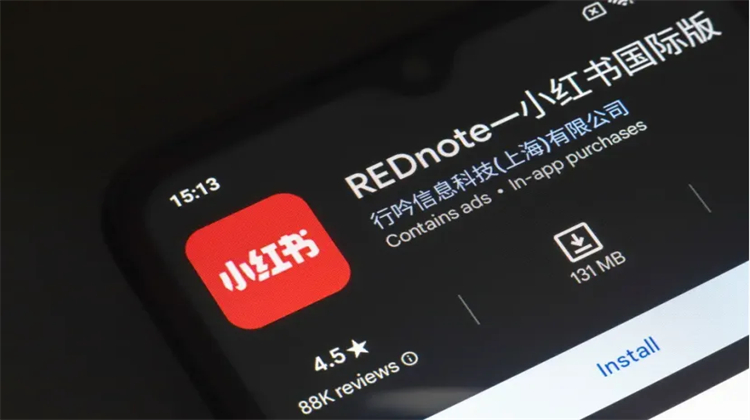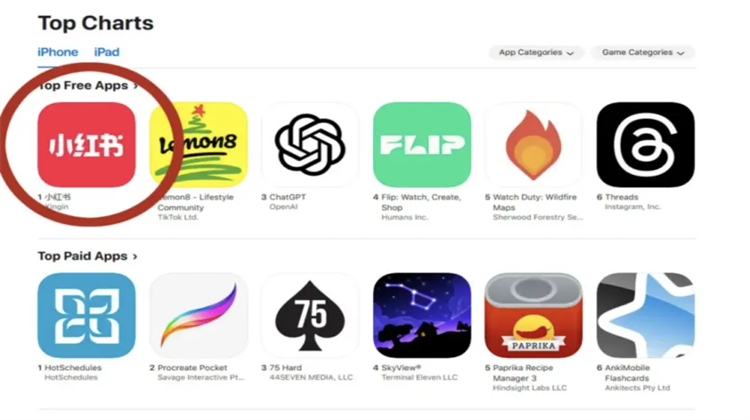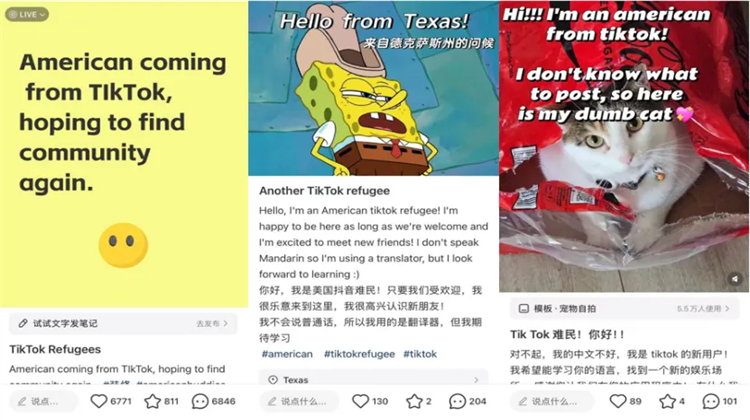A Surge of Traffic, Achieving Globalization in One Day
With the impending ban on TikTok in the United States, a large number of TikTok users have begun searching for alternative platforms. Unexpectedly, Xiaohongshu (Little Red Book) has become their "refuge."
With the impending ban on TikTok in the United States, a large number of TikTok users have begun searching for alternative platforms. Unexpectedly, Xiaohongshu (Little Red Book) has become their "refuge." The influx of these "TikTok refugees" has led to a significant rise in Xiaohongshu’s overseas traffic, sparking widespread attention. However, whether this growth can be sustained remains a key concern in the industry.
As TikTok faces the risk of being banned, Xiaohongshu has experienced a windfall. In the past 24 hours, the platform has seen a surge in English-language content.

Last Friday, the U.S. Supreme Court held oral arguments regarding the TikTok ban, with most judges leaning towards national security concerns over freedom of speech, making the implementation of the ban more likely. According to regulations, if ByteDance does not sell TikTok to a U.S.-based company, the app will be forced to shut down by January 19. ByteDance has already stated that it will not sell TikTok.
As a result of this news, many TikTok users in the U.S. have become "TikTok Refugees," seeking a new "safe haven." RedNote (the international version of Xiaohongshu), which is easy to register for and offers a user experience similar to TikTok, has become a popular new choice. American users, greeting with polite messages like "Sorry to barge in," have flooded into the Xiaohongshu community. Since Xiaohongshu does not distinguish between domestic and international content, this has sparked a global social integration on the platform.

Even though Xiaohongshu does not yet have automatic AI translation, U.S. users rely on third-party translation tools to post content. Despite this inconvenience, the wave of users joining Xiaohongshu shows no signs of slowing down. On the evening of January 13, Xiaohongshu surged to the top of the app download charts, surpassing ByteDance's "Lemon8," which was designed to take over TikTok’s position, and even OpenAI's ChatGPT, which ranked third.
With only four days remaining until January 19, the complex real-world dynamics are now mirrored in the online cyber world.

By January 14, under the topic "tiktokrefugee" on Xiaohongshu, the number of posts exceeded 77,000, with total views surpassing 38.58 million, along with over 1.16 million discussions. Meanwhile, the topic "tiktokban" also has around 15,000 posts, with total views exceeding 14.1 million.

Why did foreign TikTok users flock to Xiaohongshu, instead of ByteDance’s Lemon8 or even TikTok’s Chinese counterpart, Douyin?
The main reason is that platforms like X and other image-text platforms have suggested that RedNote is the Chinese version of TikTok. Additionally, Xiaohongshu originally targeted international students, and its account registration system is open to global phone numbers, giving it a significant advantage over Douyin, which is only available in mainland China.

As for why users didn’t flock to Lemon8, a platform also developed by ByteDance, many overseas users are concerned that if TikTok faces penalties, Lemon8 could face similar risks in the future.
According to reports from The New York Times and other media outlets, TikTok currently has 170 million monthly active users in the U.S., making up half of the country’s population and representing the largest user base globally. Since its U.S. launch in 2018, TikTok has been the most downloaded app in the U.S. in 2020, 2021, and 2022. If these users disperse to other platforms, it could represent a massive opportunity for platforms like Xiaohongshu and Lemon8.
For a long time, Xiaohongshu has been referred to as the "Chinese version of Instagram." However, compared to Instagram, TikTok, and Reddit, Xiaohongshu has a stronger advantage in community management and in-depth content creation. Instagram and TikTok are more focused on fashion and trends, while Reddit functions more as a discussion platform. Xiaohongshu combines creative and in-depth narrative features while fostering a culture of user-generated content and sharing.

This has led to a fresh perception of Xiaohongshu among some American TikTok users. The platform’s high-quality content and community-oriented features allow for a harmonious coexistence of users. Xiaohongshu’s sophisticated content algorithm allows many American users to experience a homepage that closely resembles that of TikTok, with a mix of English-language videos and images presented together on the same page.
When faced with this unexpected surge of traffic, Xiaohongshu quickly took action. It optimized its video interface to better suit the habits of TikTok users, and it strengthened content review and community management for overseas users to ensure the platform remains stable, healthy, and orderly.

As a result, Xiaohongshu-related stocks have surged. Companies associated with Xiaohongshu, such as Yi Wan Yi Chuang, saw their shares hit the 20% daily limit. Other stocks, like Dian Sheng Co., Yao Wang Technology, and Tian Xia Xiu, also saw significant gains, with Huayang Lianzhong and Yaoji Technology among the top performers.
Can Xiaohongshu handle this surge of traffic? While it has attracted some American users, there are several differences between Xiaohongshu and TikTok. TikTok has indeed fueled what is called the "influencer economy," where content creators generate massive commercial value. However, for a platform that relies on algorithmic content discovery, individual identities are less important—what truly matters is the content itself.
From a functional perspective, TikTok is entertainment-centric, drawing young users with short videos and live streams focused on creativity and visual impact. Xiaohongshu, on the other hand, focuses on social networking, e-commerce, and content sharing, with an emphasis on lifestyle sharing and helping users make informed purchasing decisions, primarily targeting young women. In terms of content format, TikTok is all about short videos, emphasizing entertainment and visual impact, while Xiaohongshu is centered around image-text posts, supplemented by short videos, offering diverse content that highlights lifestyle sharing and shopping recommendations. In terms of business models, TikTok achieves efficient monetization through ads and live-streamed sales, with high traffic costs but impressive commercial returns, while Xiaohongshu primarily relies on KOL and KOC recommendations to influence user buying decisions, with a slower but steady growth in its monetization process.
Despite their differences in market positioning, functionality, user base, and content format, Xiaohongshu and TikTok share similarities in terms of recommendation algorithms and user-generated content (UGC). Thus, if Xiaohongshu aims to maintain user engagement and effectively convert traffic in a short time, it faces significant challenges.
In terms of commercialization, while Xiaohongshu has welcomed the influx of overseas traffic, converting this traffic into substantial commercial value remains a significant challenge. Xiaohongshu will need to find viable commercialization paths without compromising user experience.
Moreover, Xiaohongshu needs to figure out how to convert overseas users into loyal, long-term users and fully tap into their commercial potential. This requires continuous innovation in product design, optimization of content operations, and development of commercial strategies.
Despite the challenges, Xiaohongshu has keenly recognized the vast potential and rare opportunities in the overseas market. In today’s increasingly complex global political and economic environment, the importance of overseas markets for Chinese internet companies is growing. Xiaohongshu can leverage this opportunity to expand its reach and attract more overseas users.
The sudden rise of Xiaohongshu in the U.S. represents a rare opportunity for the platform to expand its overseas user base, increase its international market share, and build a solid foundation for greater global influence. It also facilitates cultural exchange between China and the U.S., creating more commercial value.
However, to fully harness this surge of traffic, Xiaohongshu faces numerous challenges. On the one hand, the platform lacks a fully developed translation function, which could cause barriers in communication between U.S. users and non-English speakers, affecting interaction quality. On the other hand, the diverse nature of content posted by U.S. users increases the complexity of content moderation and management. Furthermore, ensuring user data security will be crucial for Xiaohongshu's success in the overseas market.








